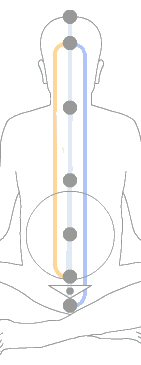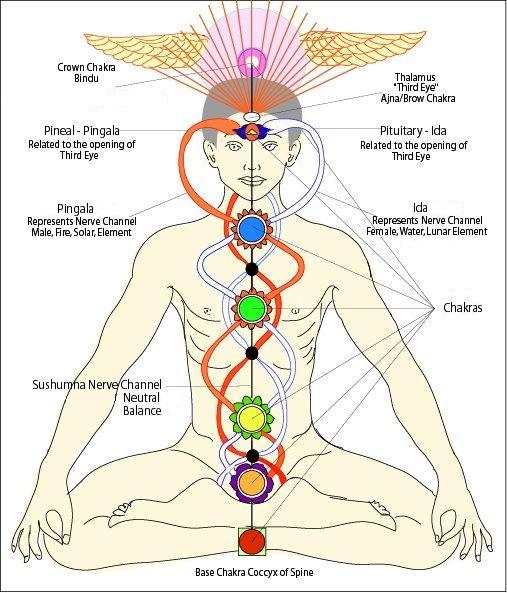 The Three Main Nadis
The Three Main Nadis
 Pingala Nadi
Pingala Nadi
The right channel (“Pingala Nadi” in Sanskrit) is also called the Sun Channel. It begins at the Swadisthan Chakra (2nd center) and travels up the right side. It crosses over to the left temple where ego of mind is active at the Ajna (Agnya) Chakra. It provides the conduit for our active energy. This energy is comprised of our mental and physical activities.
When the demand for energy on this side is too great, the left side is weakened; the desire to have joy of the Spirit evaporates. When the right side dominates, the personality becomes very dry and aggressive. Excess pressure shoots up into the left temple and into the ego, causing it to inflate into a balloon that blocks the central channel.
The entire system is thrown off balance. Blinded by ego, sensitivity to our own emotions is diminished.
Decisions and actions are taken that dominate or disrupt the lives of others with a firm belief that they are necessary and logical. Taken to this extreme, right-sided behavior leads to heart disease.
The fast-paced environments of major world’s cities and suburbs are generating predominantly right-sided citizens. It is difficult to maintain equilibrium between emotions and action when work and other activities are aggressive and stressful.
It is difficult to maintain peace and balance of the nadis energies with the accumulated negativities of daily stress clinging to the nervous system.
Shaktiananda Yoga practices are effective at removing negativity and balancing the chakras and channels. Practicing meditation daily calms the mind and emotions. Using techniques such as footsoaking, walking barefoot on the earth’s soil, or sitting under a tree are grounding and cleansing for the aura. You will experience inner joy when the energies (nadis) are balanced. The chakras become more energized and filled with light (prana) from a balanced system. You can revitalize yourself and the relationships around you simply by working on yourself from the inside out.
The state of the right channel is felt on the right side of the body. In the beginning, it is most easily felt on the right palm.
 Ida Nadi
Ida Nadi
The left channel (“Ida Nadi” in Sanskrit) is also called the Moon Channel. It begins at the Mooladhara (1st chakra) and runs up the left side, crossing over at the Agnya Chakra (6th center) into the temple and superego on the right side of the brain. It provides the conduit for the energy of our desire.
From these desires or wishes, our emotions are triggered. Emotions are actually desires that have not yet materialized. These desires and the attendant feelings about them travel through this left channel to the appropriate places in the body to bring about the actions of fulfillment. Our desires are essential for action.
The greatest quality of the left side is to provide joy which is the steady condition of the Spirit. The desire for this joy is still alive inside us the same as it was when we were infants. It may be blocked or covered with “tarnish” from emotional or physical injuries experienced in living life. The practice of Shaktiananda Yoga helps us remove those old tensions and recover that joy as a steady state of being.
Problems of the left side tend to result in passivity or emotional extremism whereby we are thrown between elation and depression. With this type of imbalance, self-discipline becomes difficult and bad habits become hard to correct. In the worst case, we become lethargic and self-obsessed. Because this channel feeds also into the skull area, pressure on the brain becomes excessive. This cycle is what causes such problems as mental breakdown, epilepsy, and senility (decay of the brain).
The state of the left channel is felt on the left side of the body. In the beginning it is most easily felt on the left palm.
 Sushumna Nadi
Sushumna Nadi
The central channel (“Sushumna Nadi” in Sanskrit) is also called the Middle Path. It begins at the place where the Kundalini resides and passes straight up the spine to the highest chakra (the 7th or Sahasrara Chakra).
As the conduit for the parasympathetic nervous system, the central channel coordinates our involuntary or autonomic nervous system activities. We do not have conscious control over these activities.
Our heart beats, our lungs breathe, our blood system manufactures plasma, our brain centralizes and coordinates communication, and our mind is constantly handling information.
The activities that take place through the parasympathetic system are spontaneous happenings. They happen naturally, without our doing anything. The rising of the Shakti Kundalini and Her work, as well as all spiritual activities, are spontaneous. Hence the term Shaktiananda was selected to label this type of yoga because it means bliss in the rising of the Shakti Kundalini. The implication of the parasympathetic nature of the Middle Path is that the rise of the Kundalini is totally beyond our own volition or control. The guru acts as a catalyst in providing spiritual guidance and Shaktipat initiation.
Once our Kundalini has been awakened and has traveled through this central channel and out the top of the head, we can begin to become aware of the vast internal galaxy of our subtle system. This initial “enlightenment” or realization is only the beginning of our greatest adventure at the Swadisthan Chakra (2nd center) and travels up the right side. It crosses over to the left temple (ego of mind) at the Ajna (Agnya) Chakra. It provides the conduit for our active energy. This energy is comprised of our mental and physical activities.
When the demand for energy on this side is too great, the left side is weakened; the desire to have joy of the Spirit evaporates. When the right side dominates, the personality becomes very dry and aggressive. Excess pressure shoots up into the left temple and into the ego, causing it to inflate into a balloon that blocks the central channel.
The entire system is thrown off balance. Blinded by ego, sensitivity to our own emotions is diminished. Decisions and actions are taken that dominate or disrupt the lives of others with a firm belief that they are necessary and logical. Taken to this extreme, right-sided behavior leads to stress on the heart and nervous system which leads to disease.
Yoga exercises (postures) and the practice of Meditation increase the flow of energy (prana) in the sushunmna. The breath should be more active in ida (moon) at sunrise and during the day – and the breath should be more active in Pingala (sun) at sunset and predominately throughout the night. Let the breath flow through Ida the whole day and through Pingala the whole night.
How To Charge The Flow In The Nadis
The following exercises are for changing the flow from Ida to Pingala. Select any one of the methods that suits you best. for changing the flow from Pingala to Ida just do the same exercise on the opposite side.
Sunset : Pingala
1. Plug the left nostril with a small piece of cotton or fine cloth for a few minutes.
2. Lie down on the left side for ten mintues.
Do exercise one & two together
3. Sit erect. Draw the left knee up and keep the left heel near the left bottock. Now press the left arm-pit, Axilla, on the knee. In a few seconds the flow will be through the Pingala.
4. The flow of breath can be changed by Nauli Kriya also because it directly exercises the stomach and diaphram. Other benefits of Nauli Kriya: removes the impurities stuck on the lining of the intestines, removes constipation, obesity and dyspepsia. The liver, spleen and other glands are influenced by this practice.
Sunrise : Ida
1. Plug the right nostril with a small piece of cotton or fine cloth for a few minutes.
2. Lie down on the right side for ten mintues.
Do exercise one & two together
3. Sit erect. Draw the right knee up and keep the right heel near the right bottock. Now press the right arm-pit, Axilla, on the knee. In a few seconds the flow will be through the Ida.
4. The flow of breath can be changed by Nauli Kriya also.
Please Note
The above exercises are intended for general regulation of breath.
Out of the innumerable Nadis 14 are said to be important

